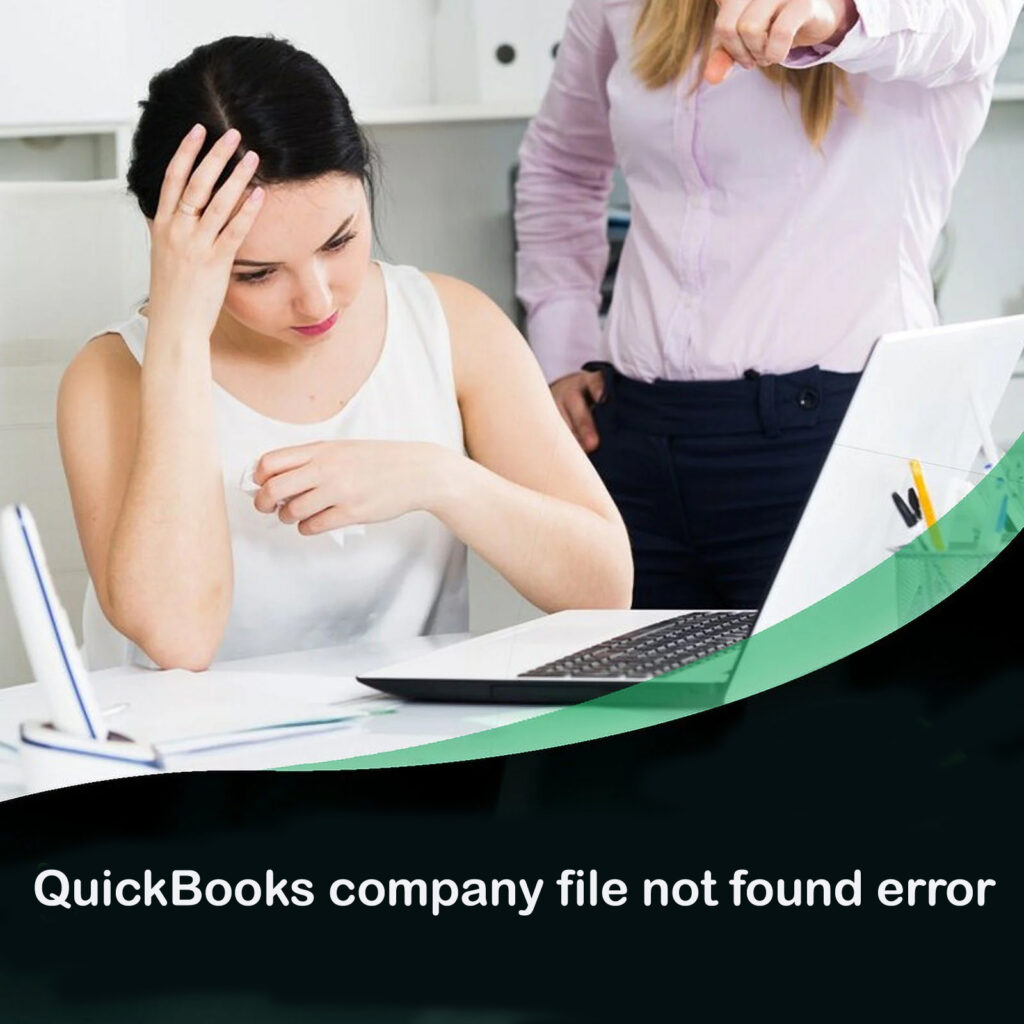QuickBooks Company File Cannot Be Found.
QuickBooks Company File Cannot Be Found.
This is a serious matter. Hence, it would help if you addressed it right away, as your firm file was
renamed or transferred. We shall be clarifying some clear, pragmatic elements that lead to the
missing business file in this part, as well as some well-chosen fixes for the same. Thus, explore this
section to gain a better knowledge of this mistake and also to learn some simple fixes for either
QuickBooks desktop company file missing or found or QuickBooks desktop cannot open business file
problem.

Reasons for QuickBooks business file not found issue.
As was already noted, many different factors could cause QuickBooks company file won't open issue.
We have mentioned some of the typical causes here.
- The company file name is overly long.
- The File QBWUSER.INI is either missing or corrupted.
- Additionally, this problem could damage your hard disk.
- Should the application files become corrupted,
- Should the desktop version of QuickBooks you are now using be inaccurate?
- Files and data in QuickBooks are corrupted.
- Should the placement of the QBW file—which includes access permission—cause problems, you could run across this error.
- An opposing QBW.tlg file

Pre-requisites for fixing the QuickBooks company file not found error
There are a few steps you should do before you straight enter the fixation procedure:
- You have to find out whether the problem lies in the corporate file rather than the program.
- Verify that your QuickBooks version is current.
- We also advise you to check whether your QuickBooks application is corrupted.
- The corporate file should be housed in just one system.
QuickBooks Company File Not Found or Missing Solutions
Use the techniques below to address the QuickBooks company file missing or not found error. Let's
examine closely every one of these troubleshooting techniques:
Case 1: Getting at the locally kept QuickBooks file on the system
Method 1: Locate all corporate files.
This is an easy approach; the user has to put an asterisk (*) directly before the extension type. The
following file extensions must be found:
For QuickBooks Company Files: *qbw; for Backup Files: *qbb; for Accountants Copy Files: *qba; for
Accountant Transfer Files: *qbx; for Accountant Changes Files: *qby
Once the files have been located, record their whereabouts and proceed to the fix. Should the file
elude detection, you will have to speak with an IT specialist.
Method 2: Open File in QuickBooks
You would have to see the file using QuickBooks. As directed below:
Step 1: Open the company file or an accountant copy
- From the File menu, pick Open or Restore Company.
- Choose Next from Open a Company File.
- Now strike on the Company file and then select the Open option.
Step 2: Restore the backup of the .qbb file extension
- Select Open or Restore business from the File menu, then click Restore backup file and select Next.
- Choose Local Backup next.
- Select the Company file and tap on the Next tab.
- Choose the place to save the repaired file.
Step 3: Recovery of Accountants copy transfer file
- The File menu's Open or Restore Company option helps.
- You would also have to hit Next from a copy transfer file provided by an accountant.
- Choose Next on the "If what the accountants copy" prompt after that.
- Now open and hit on the Transfer file.
- At last, decide where the file will be kept and select the Save tab.
Case 2: Accessing QuickBooks file over the network
Method 1: Verify the network connectivity
Under this procedure, you would have to find the server system's name. Use the following
guidelines:
- Hit R plus Win keys.
- Run the dialog box open afterward.
- Type in CMD after that and hit the Enter key.
- Type ipconfig/all, then hit the Enter key.
- Record the server names.
- Type Ping, then the server's name in the Next window.
- Click the Enter tab.
- Every pocket will have a response.
- Should you experience any packet loss, the network connection is likely to be faulty.
Method 2: Find the QuickBooks company file
Windows can search for file types.
Here, you should click the Windows start tab and type the firm File's extension together with the
asterisk sign (*) in the search programs and files search box:
*.qbw—working files
*.qbb, or backup files
Accountants copy files with *.qba; they transfer files with *.qbx.
*.qby (accountant file modifications)
Right-click the file when you have located it to select the Open file location tab.
From the proper place, open the file to find the mistake.
QuickBooks Company File Won't Open? Try These
Should the strategies above not be applicable to you, then you should use the following instead.
Method 1: Copy the company file to a new location
This approach calls for you to Create a New folder in C: disk.
Then, access the folder where the company file is kept.
Press and hold the Ctrl key, then select the Company File together with the matching.tag file.
You would then have to choose the Copy option by right-clicking.
Open the new folder, right-click, and press on the Paste option to wrap the process.
Method 2: Check for the properties and file extension
To access the file, open the folder.
Select Properties by right-clicking the Company file.
Be sure the file is 7MB and QuickBooks corporate.
Make sure compress and encrypt boxes are off on the Advanced tab.
End the procedure with OK.
Method 3: QuickBooks update and file type check
Getting QuickBooks current to the latest edition comes first. The help tab in QuickBooks allows one
to do this. Another way out is to get the Intuit downloaded file.
Verify the extension of the company file after updates. It should just feature the QBW extension.
One should stay away from remaining extensions like QBB, QBM, etc.
Furthermore, absent from the file should be compression. In relation to this:
- Click right at QB company file.
- Next, go to Properties, then the Advanced tab.
- Under "Clear the Compress and Encrypt," indicate the box next to it.Point to the box next to "Clear the Compress and Encrypt" there.
- In essence, "click on OK."
Method 4: Open a sample company file
In QuickBooks, open an example file. It will verify whether QuickBooks or the company file has
problems.
Hold Ctrl on your keyboard for this and launch QuickBooks while it is still pressed. Hold onto Ctrl till
QuickBooks opens.
Choose and open a sample file.
Method 5: When closing QuickBooks, don't save desktop.
After closing corporate files, QuickBooks opens windows. Large reports or automated windows will
freeze QuickBooks on launch.
Opening your company file without saved windows:
- Choose the company file using Open QuickBooks Desktop and the No Company Open.
- Keep holding the ALT key, then hit Open. Release ALT just when the file opens. Release ALT, enter your password, and let QuickBooks ask you to sign in. Press and hold ALT once more; then, choose OK.
- Should your business open successfully, turn off Save the desktop when closing preference.
- Go to Edit and then Preferences.
- Here, select desktop view and avoid saving the desktop.
- Then strike on OK.
- Should it open with success, you are in good shape.
Method 6: Disable workstation hosting.
Turn off Host Multi-User Access on your workstations if you house your company file on a network.
The file should live on just the server computer.
To turn off hosting on your workstations:
- Open QuickBooks on one of your workstations first.
- Close your company file not opening. Rather, start a file and then Utilities.
- See Host Multi-User Access; do not choose it. Go on to the next workstation. This one is not the issue.
- Choose the Stop Hosting Multi-User Access if you see it.
- Go through these actions on every one of your workstations.
- Go to your server computer after looking over your workstations. Your company's files are usually housed on this PC.
- On your server PC, open QuickBooks.
- First open utilities, then file. Choose Host Multi-User Access if available.
- Configure multi-user beginning and stopping.
- Select File, Utilities, Stop Hosting Multi-User Access.
- After File, Utilities, click Host Multi-User Access.
- Try opening your business file again.

